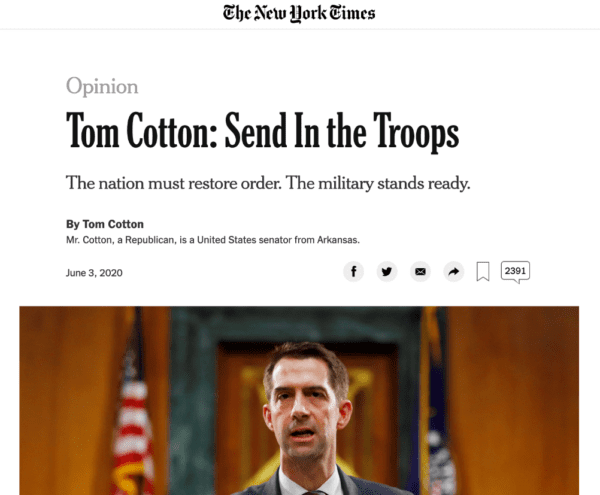
The New York Times’ Editorial Editor, James Bennet, recently resigned from his position amid backlash following the publication of a controversial opinion piece by Arkansas Republican Senator Tom Cotton (Tracy, 2020). The op-ed titled “Send in the Troops” called for the deployment of U.S. military forces to aid local law enforcement in cities like New York and Minneapolis, which have been major sites of citizen protest since the brutal killing of George Floyd by police in May 2020. Cotton contended that the originally peaceful protests transformed into violent riots after being infiltrated by “cadres of left-wing radicals” to the point that only “one thing [can] restore order to our streets: an overwhelming show of force to disperse, detain and ultimately deter lawbreakers” (Cotton, 2020). Though Cotton’s “needlessly harsh tone” should have been a red flag, The New York Times staff admitted that the editing process was overly rushed and the piece was not properly scrutinized (NYTimes correction on Cotton, 2020). Thus, even the publishing paper seemed to admit that many of Cotton’s claims were unsubstantiated, exaggerated, or out-of-context—but only after they had been published and had offended thousands of readers.
Despite the current cultural relevancy of Cotton’s now infamous op-ed, this incident was not just a one-time mistake nor the first controversy Bennet has faced criticism for in his role overseeing The New York Times editorials. For example, in April 2019 the paper had to formally apologize for an anti-Semitic cartoon in the Opinion pages which was published “without adequate oversight because of a faulty [review] process” (Cowley, 2019). More recently in August 2019, an appellate court ruled that Sarah Palin’s 2017 defamation lawsuit could go forward against The New York Times after a groundless op-ed was published linking the former Alaska Governor to the shooting of Arizona Congresswoman Gabrielle Giffords (Tracy, 2019). While The New York Times is not the only news organization to have published controversial opinion pieces, these recent instances provide an opportunity to assess the ethical implications of op-eds in journalism overall: Where is the line drawn between apologizing for inaccuracy vs. apologizing because the article voices a controversial viewpoint?
Driven by Bennet’s resignation over the Cotton controversy, The Washington Post’s Editorial Board took a clear stand that they “are not The New York Times” and published a statement titled “These pages won’t wilt under cancel-culture” (Board, 2020). Here the board explained that, unlike the fairly covered and well-researched news articles produced by professional journalists, the opinion section is meant to offer alternative viewpoints that would not be seen in traditional news coverage (Board, 2020). Similarly, before Bennet eventually conceded that the Cotton piece was inappropriate for distribution, he originally released a statement defending the publication of the Senator’s editorial:
We published Cotton’s argument in part because we’ve committed to Times readers to provide a debate on important questions like this. It would undermine the integrity and independence of The New York Times if we only published views that editors like me agreed with, and it would betray what I think of as our fundamental purpose — not to tell you what to think, but to help you think for yourself (Bennet, 2020).
Kathleen Parker, a columnist at The Washington Post, also voiced her disappointment to Bennet’s resignation, saying: “How could a newspaper intent on airing differing opinions and diverse voices decide that a sitting U.S. senator’s viewpoint didn’t measure up? Allowing a senator to espouse thoughts one might find objectionable is exactly the point of the op-ed page” (Parker, 2020).
However, critics have pointed out that, in most cases, op-eds are misleading. In Bennet’s case, the Editorial Board reported that there were multiple unsubstantiated statements in Cotton’s “Send in the Troops” (NYTimes correction on Cotton, 2020). Likewise, at The Wall Street Journal, nearly 300 staff members signed a letter to their publisher, Almar Latour, citing various occurrences in which the Opinion pages contained inaccuracies, ranging from completely false information to the selective inclusion and/or exclusion of relevant facts (Trachtenberg, 2020). One instance mentioned by name was Vice President Mike Pence’s op-ed “There Isn’t a Coronavirus ‘Second Wave’” (“Letter from WSJ Staff to Publisher Almar Latour,” 2020). In this case, statistics that had not been fact-checked were cited even though “scrutinizing these numbers would have required no more than a Google search” (“Letter from WSJ Staff to Publisher Almar Latour,” 2020). Furthermore, a correction was issued only after the piece had been in circulation for several days, allowing time for millions of readers to intake and potentially spread the false information (“Letter from WSJ Staff to Publisher Almar Latour,” 2020). Though the editorial section is specifically reserved for opinions of non-journalists, citizens are likely to assume that anything published by a highly regarded news organization has undergone some kind of review process and thus may take op-eds at face-value without further investigation. Even if such assumptions by readers are not the fault of the organization, news outlets nonetheless have a larger responsibility to provide the public with correct information than they do to provide a platform for opinions, which includes anticipating public misunderstandings and publishing or declining certain op-eds accordingly.
While it may be true that many editorials are misleading, this is not necessarily true in all cases. For example, The Philadelphia Inquirer’s top editor, Stan Wischnowski, also resigned from his position this year after a controversial op-ed by Inga Saffron, the Inquirer’s architecture critic, was published with the headline “Buildings Matter, Too.” The piece discussed the destruction of architecture during the nationwide protests against police violence towards African Americans (McCoy, 2020). Though many readers and staff members were offended by this piece’s appropriation of Black Lives Matter rhetoric for the sake of property, it nonetheless empathized with protesters and contained no inaccuracies.
Journalism has always had to come to terms with the interplay of inferences, opinions, and factual statements. Opinion pieces do not purport to be mere reporting of facts, but how far can the emphasis on opinion and debatable inferences and claims go? If one sees the point of the news as simply the conveyance of truth, or agreed upon factual claims, the advisability of continuing the practice of including op-eds in newspapers might be in doubt. News organizations have typically aimed to be as unbiased as possible concerning their Opinion section, providing a platform for a variety of viewpoints and opinions. What happens if many readers find that certain opinions aren’t informed, or draw judgments and conclusions that others disagree with? Should the standards governing whose opinions are included be revised when audiences at large are offended by or disagree with the perspective in question?
Discussion Questions:
- What values are in conflict when a paper publishes a controversial op-ed piece like Cotton’s editorial?
- Should newsrooms continue to publish op-eds if they know that they will be controversial? Where is the line between a controversial piece and an offensive piece?
- Should senior supervisors in newsrooms take the blame for articles written by someone under them? Is resigning or being fired an adequate punishment for a piece deemed offensive and controversial?
- Are newsrooms putting themselves at financial risk by publishing op-eds ridiculed by their audience? Should economic concerns be placed above concerns for giving a voice to those with unpopular viewpoints?
- In the age of the internet, almost anyone can have their opinions heard using social media or blogging platforms. Does new technology render traditional op-eds in newspapers obsolete? Why or why not?
Further Information:
Bennet, J. (2020, June 4). “Why We Published the Tom Cotton Op-Ed.” The New York Times. Available at: https://www.nytimes.com/2020/06/04/opinion/tom-cotton-op-ed.html
Board, T. (2020, July 23). “Opinion | A Note to Readers.” The Wall Street Journal. Available at: https://www.wsj.com/articles/a-note-to-readers-11595547898
Cotton, T. (2020, June 3). “Tom Cotton: Send in the Troops.” The New York Times. Available at: https://www.nytimes.com/2020/06/03/opinion/tom-cotton-protests-military.html
Cowley, S. (2019, April 28). “Times Apologizes for Publishing Anti-Semitic Cartoon.” The New York Times. Available at: https://www.nytimes.com/2019/04/28/business/ny-times-anti-semitic-cartoon.html
Letter from WSJ Staff to Publisher Almar Latour.” (2020, July 21). The Wall Street Journal. Available at: https://int.nyt.com/data/documenttools/letter-from-wsj-news-staff-to-publisher-almar-latour/ea78fefb574b76a6/full.pdf
McCoy, C. (2020, June 7). “Stan Wischnowski resigns as The Philadelphia Inquirer’s top editor.” The Philadelphia Inquirer. Available at: https://www.inquirer.com/news/stan-wischnowski-resigns-philadelphia-inquirer-20200606.html
Parker, K. (2020, July 14). “Opinion | Bari Weiss’s resignation letter showed all that’s wrong with modern newsrooms.” The Washington Post. Available at: https://www.washingtonpost.com/opinions/bari-weisss-resignation-letter-showed-all-thats-wrong-with-modern-newsrooms/2020/07/14/66524a18-c60f-11ea-b037-f9711f89ee46_story.html
Trachtenberg, J. (2020, July 21). “WSJ Journalists Ask Publisher for Clearer Distinction Between News and Opinion Content.” The Wall Street Journal. Available at: https://www.wsj.com/articles/wsj-journalists-ask-publisher-for-clearer-distinction-between-news-and-opinion-content-11595349198
Tracy, M. (2019, August 6). “Sarah Palin’s Defamation Suit Against New York Times Is Reinstated.” The New York Times. Available at: https://www.nytimes.com/2019/08/06/business/sarah-palin-lawsuit-new-york-times.html
Tracy, M. (2020, June 7). “James Bennet Resigns as New York Times Opinion Editor.” The New York Times. Available at: https://www.nytimes.com/2020/06/07/business/media/james-bennet-resigns-nytimes-op-ed.html
Authors:
Claire Coburn & Scott R. Stroud, Ph.D.
Media Ethics Initiative
Center for Media Engagement
University of Texas at Austin
December 15, 2020
Image: nytimes.com
This case study is supported by funding from the John S. and James L. Knight Foundation. It can be used in unmodified PDF form for classroom or educational settings. For use in publications such as textbooks, readers, and other works, please contact the Center for Media Engagement.
Ethics Case Study © 2020 by Center for Media Engagement is licensed under CC BY-NC-SA 4.0



